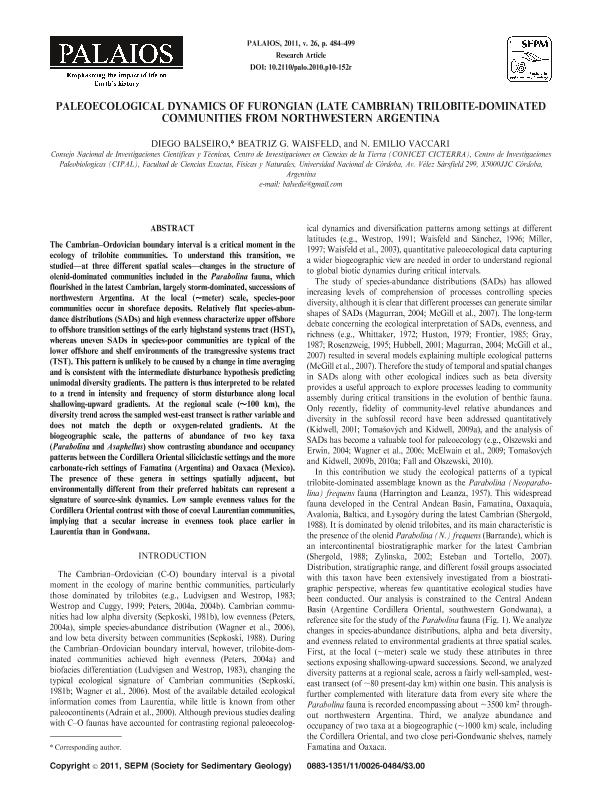Mostrar el registro sencillo del ítem
dc.contributor.author
Balseiro, Diego

dc.contributor.author
Waisfeld, Beatriz Graciela

dc.contributor.author
Vaccari, Norberto Emilio

dc.date.available
2018-07-23T18:39:48Z
dc.date.issued
2011-08-15
dc.identifier.citation
Balseiro, Diego; Waisfeld, Beatriz Graciela; Vaccari, Norberto Emilio; Paleoecological dynamics of furongian (late cambrian) trilobite-dominated communities from northwestern Argentina; Society for Sedimentary Geology; Palaios; 26; 8; 15-8-2011; 484-499
dc.identifier.issn
0883-1351
dc.identifier.uri
http://hdl.handle.net/11336/52864
dc.description.abstract
The Cambrian–Ordovician boundary interval is a critical moment in the ecology of trilobite communities. To understand this transition, we studied—at three different spatial scales—changes in the structure of olenid-dominated communities included in the Parabolina fauna, which flourished in the latest Cambrian, largely storm-dominated, successions of northwestern Argentina. At the local (,meter) scale, species-poor communities occur in shoreface deposits. Relatively flat species-abundance distributions (SADs) and high evenness characterize upper offshore
to offshore transition settings of the early highstand systems tract (HST), whereas uneven SADs in species-poor communities are typical of the lower offshore and shelf environments of the transgressive systems tract (TST). This pattern is unlikely to be caused by a change in time averaging and is consistent with the intermediate disturbance hypothesis predicting unimodal diversity gradients. The pattern is thus interpreted to be related to a trend in intensity and frequency of storm disturbance along local shallowing-upward gradients. At the regional scale (,100 km), the diversity trend across the sampled west-east transect is rather variable and does not match the depth or oxygen-related gradients. At the biogeographic scale, the patterns of abundance of two key taxa (Parabolina and Asaphellus) show contrasting abundance and occupancy patterns between the Cordillera Oriental siliciclastic settings and the more carbonate-rich settings of Famatina (Argentina) and Oaxaca (Mexico). The presence of these genera in settings spatially adjacent, but environmentally different from their preferred habitats can represent a signature of source-sink dynamics. Low sample evenness values for the Cordillera Oriental contrast with those of coeval Laurentian communities, implying that a secular increase in evenness took place earlier in Laurentia than in Gondwana.
dc.format
application/pdf
dc.language.iso
eng
dc.publisher
Society for Sedimentary Geology

dc.rights
info:eu-repo/semantics/openAccess
dc.rights.uri
https://creativecommons.org/licenses/by-nc-sa/2.5/ar/
dc.subject
Diversity
dc.subject
Evenness
dc.subject
Disturbance
dc.subject
Evolutionary Fauna
dc.subject.classification
Meteorología y Ciencias Atmosféricas

dc.subject.classification
Ciencias de la Tierra y relacionadas con el Medio Ambiente

dc.subject.classification
CIENCIAS NATURALES Y EXACTAS

dc.title
Paleoecological dynamics of furongian (late cambrian) trilobite-dominated communities from northwestern Argentina
dc.type
info:eu-repo/semantics/article
dc.type
info:ar-repo/semantics/artículo
dc.type
info:eu-repo/semantics/publishedVersion
dc.date.updated
2018-07-11T17:49:04Z
dc.identifier.eissn
1938-5323
dc.journal.volume
26
dc.journal.number
8
dc.journal.pagination
484-499
dc.journal.pais
Estados Unidos

dc.journal.ciudad
Lawrence
dc.description.fil
Fil: Balseiro, Diego. Consejo Nacional de Investigaciones Científicas y Técnicas. Centro Científico Tecnológico Conicet - Córdoba. Centro de Investigaciones en Ciencias de la Tierra. Universidad Nacional de Córdoba. Facultad de Ciencias Exactas Físicas y Naturales. Centro de Investigaciones en Ciencias de la Tierra; Argentina. Universidad Nacional de Córdoba. Facultad de Ciencias Exactas Físicas y Naturales. Centro de Investigaciones Paleobiológicas; Argentina
dc.description.fil
Fil: Waisfeld, Beatriz Graciela. Consejo Nacional de Investigaciones Científicas y Técnicas. Centro Científico Tecnológico Conicet - Córdoba. Centro de Investigaciones en Ciencias de la Tierra. Universidad Nacional de Córdoba. Facultad de Ciencias Exactas Físicas y Naturales. Centro de Investigaciones en Ciencias de la Tierra; Argentina. Universidad Nacional de Córdoba. Facultad de Ciencias Exactas Físicas y Naturales. Centro de Investigaciones Paleobiológicas; Argentina
dc.description.fil
Fil: Vaccari, Norberto Emilio. Consejo Nacional de Investigaciones Científicas y Técnicas. Centro Científico Tecnológico Conicet - Córdoba. Centro de Investigaciones en Ciencias de la Tierra. Universidad Nacional de Córdoba. Facultad de Ciencias Exactas Físicas y Naturales. Centro de Investigaciones en Ciencias de la Tierra; Argentina. Universidad Nacional de Córdoba. Facultad de Ciencias Exactas Físicas y Naturales. Centro de Investigaciones Paleobiológicas; Argentina
dc.journal.title
Palaios

dc.relation.alternativeid
info:eu-repo/semantics/altIdentifier/doi/http://dx.doi.org/10.2110/palo.2010.p10-152r
dc.relation.alternativeid
info:eu-repo/semantics/altIdentifier/url/https://www.crossref.org/iPage?doi=10.2110%2Fpalo.2010.p10-152r
Archivos asociados
